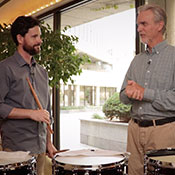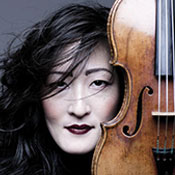
Dean Borghesani: From rock drummer to principal timpanist
David Lewellen
PUBLISHED
Tagged Under: MSO Musicians, Percussion, Timpani
When Dean Borghesani talks about his work, the conversation is peppered with musicians who taught him and mentored him, both before and after he became the Milwaukee Symphony’s principal timpanist in 2000. He’ll also talk about all the techniques he had to figure out for himself, and about all the younger players whose careers he has helped to launch.
But as a teenager, Borghesani’s ambition was to be a drummer in a rock band — “until my dad put the hammer down and said, ‘You’re going to college.’ I never listened to classical music as a teenager.” He arrived on the campus of Catholic University in Washington, D.C., signed up for several ensembles, “and they said, ‘You’re playing the timpani’ and I said, ‘What’s that?’”
Well … the timpani, also known as kettledrums, are the only tuned drums in the orchestra, sounding a definite pitch. In music written before the early 1800s, they are usually the only percussion instrument, and the timpanist is the only percussionist in the orchestra who almost never plays other drums.
For music by Mozart and earlier composers, a timpanist can tune two drums – one on the first note of the scale, one on the fifth – and leave them there for the duration of the piece. Beethoven, however, shifts keys from movement to movement, and for Mahler or Richard Strauss, Borghesani might need an array of six drums, or a quick foot on the pedal to change the note, or both. Live movie soundtracks are especially hard, since they were written for performance in a studio, recording a few bars at a time. “Sometimes I have to try to remember what drum the note is on.”
Borghesani’s real education began when he got a position with the part-time Annapolis Symphony, “sitting in the chair and learning the repertoire — what works, what doesn’t work, why is the conductor yelling at me.” He also got hired as a percussionist for many touring Broadway shows at the Kennedy Center in Washington, where “the money was great but it wasn’t particularly rewarding.”
So he spent years on the audition trail, pursuing an elusive full-time timpani job, and learning the hard way not only how to play but how to learn. As a young musician, “I didn’t know the right questions to ask,” he said. But Charles Wilkinson at the National Symphony worked with him to “undo all the work I had put in and relearn it until it felt normal.” That level of preparation “is hard work and it’s not necessarily fun. But I knew that if 100 people showed up to an audition, maybe four had done the work I had done.”
The red pocket square that he customarily wears for performances is a reminder of another former teacher: the late Fred Begun, principal timpanist of the National Symphony, who gave Borghesani many free lessons and informal advice while he was auditioning, “and when I won the Milwaukee job, he gave me that pocket square to commemorate all we did to get this job together.”
Now, Borghesani teaches musicians (not just timpanists) “how to be a good student and how to make the most of your practice time. Don’t just play it ten times – you’ll be learning it wrong.” He has his students videotape themselves for instant feedback. When he was young, before video was cheap and easy, he set up mirrors so that he could watch his hands in action.
Eight years ago, Borghesani got an email from a nanotechnology engineer in Chicago who wanted to go back to his first love of playing the timpani. The student showed up, recorded the lesson, and came back with a flow chart of everything Borghesani had told him. The practice habits must have paid off, because the student, Jason Haaheim, is now the principal timpanist of the Metropolitan Opera.
Every timpanist has to think a lot about equipment. Borghesani owns the drums that he plays at Uihlein Hall (which is somewhat unusual in the orchestra world) and has another set at home. At Uihlein, he has to work hard to get the right sound — “it’s loud onstage, but the sound doesn’t get off.” But when the orchestra moves into the Warner Grand Theater in 17 months, he expects he’ll need less power and a lighter touch. He remembers the sound-check rehearsal that the MSO did in the Warner Grand more than a decade ago, when he stood in the top balcony and overheard two violinists whispering onstage.
During rehearsal, he’ll keep about eight pairs of sticks on his stand and experiment to arrive at the best sound. “I have hundreds of pairs of sticks in my basement at home, and it drives my wife crazy,” he said. “They’re always coming out with more, but you always wind up going back to your favorites.”
Borghesani lives in Shorewood with his wife, Kathi, who retired last year as director of the Whitefish Bay High School orchestra. “She’s sleeping like a teenager,” he joked. The couple enjoy cooking and socializing with friends and neighbors.
Currently he has one student: “She’s a high school junior and she’s performing at the level of a graduate student in a major conservatory.” But he usually advises his students to major in something else and minor in music; the odds of parlaying the very expensive conservatory degree into a paying career are very poor, no matter how elite the school. “It’s a huge responsibility. I care about their future.”



